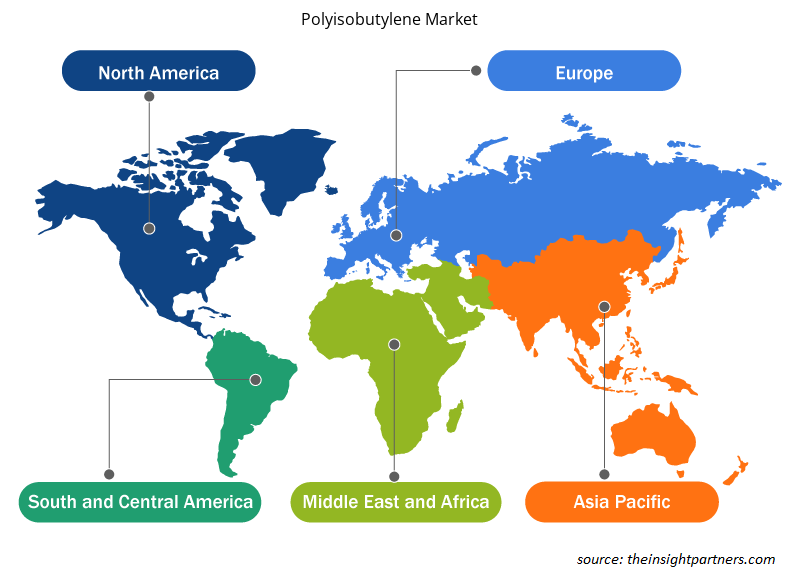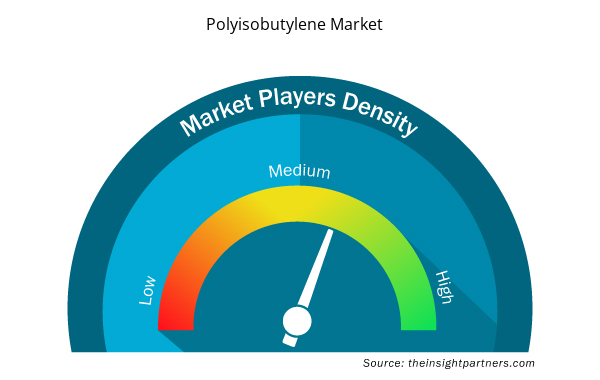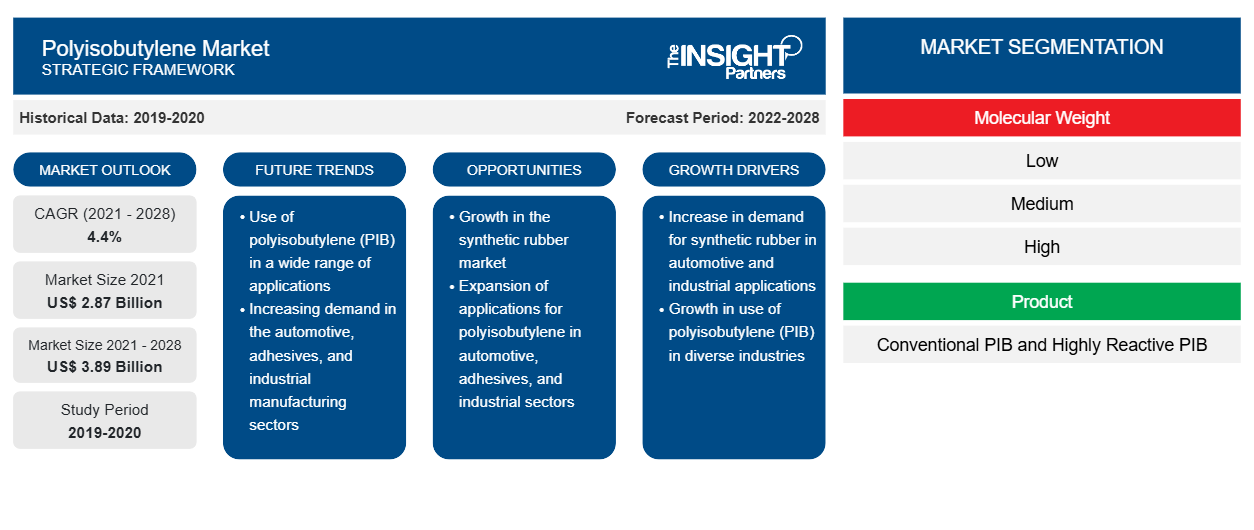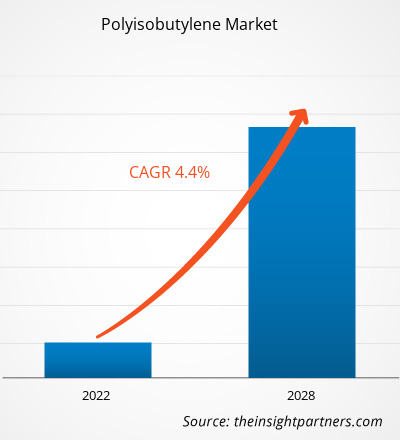[Rapporto di ricerca] Il mercato del poliisobutilene è stato valutato a 2.871,14 milioni di dollari nel 2021 e si prevede che raggiungerà i 3.891,16 milioni di dollari entro il 2028; si prevede che crescerà a un CAGR del 4,4% dal 2021 al 2028.
Il poliisobutilene (PIB) è un elastomero o una gomma sintetica. In base al peso molecolare, il mercato è suddiviso in basso, medio e alto. È un liquido viscoso versatile, non tossico e bianco come l'acqua. Il poliisobutilene può aumentare l'appiccicosità, fornire idrorepellenza, migliorare l'indice di viscosità e fornire un eccellente isolamento elettrico.
Nel 2020, il Nord America ha detenuto la quota di fatturato più grande del mercato globale del poliisobutilene . Le crescenti richieste da varie applicazioni, come trasporti, agrochimica, elettricità e adesivi, guidano la crescita del mercato in Nord America. Il poliisobutilene è sempre più utilizzato nei settori dei trasporti, alimentare ed edile in quanto offre bassa permeabilità ai gas, eccellente resistenza alla trazione, elevata resistenza chimica e maggiore rigidità.
Personalizza questo report in base alle tue esigenze
Riceverai la personalizzazione gratuita di qualsiasi report, comprese parti di questo report, o analisi a livello nazionale, pacchetto dati Excel, oltre a usufruire di grandi offerte e sconti per start-up e università
- Scopri le principali tendenze di mercato in questo rapporto.Questo campione GRATUITO includerà analisi di dati che spaziano dalle tendenze di mercato alle stime e alle previsioni.
Impatto della pandemia di COVID-19 sul mercato del poliisobutilene
La pandemia di COVID-19 ha alterato drasticamente lo stato del settore chimico e dei materiali e ha avuto un impatto negativo sulla crescita del mercato del poliisobutilene. L'industria chimica e dei materiali globale è una delle principali industrie che ha subito gravi interruzioni a causa della pandemia, come interruzioni della catena di fornitura, cancellazioni di eventi tecnologici e chiusure di uffici. I divieti di viaggio globali imposti dai paesi in Europa, Asia e Nord America stanno influenzando le collaborazioni aziendali e le opportunità di partnership. Si prevede che tutti questi fattori influenzeranno negativamente l'industria elettronica e chimica e dei materiali, il che ostacola la crescita di vari mercati correlati a queste industrie. Tuttavia, poiché le economie stanno pianificando di rilanciare le loro operazioni, si prevede che la domanda di poliisobutilene aumenterà a livello globale. La domanda di poliisobutilene dai settori dei lubrificanti industriali a valle e degli additivi per lubrificanti ha iniziato a crescere con la ripresa delle attività commerciali e la revoca delle misure di blocco a livello globale. Approfondimenti di mercato
L'industria automobilistica alimenterà la crescita del mercato durante il periodo di previsione
Per l'industria automobilistica, le prestazioni dei motori per svolgere le loro funzioni quotidiane sono importanti. L'industria automobilistica è stata il mercato chiave per diversi tipi di additivi per carburante per molti anni. La quota per le automobili è stata costantemente superiore a quella degli altri segmenti di mercato degli additivi per carburante a causa della mancanza di alternative efficienti ai combustibili fossili e di una crescente economia della classe media. L'importanza relativa dell'aviazione per gli additivi per carburante è aumentata negli ultimi anni, aumentando in ultima analisi la domanda di poliisobutilene.
Approfondimenti sulle applicazioni
In base all'applicazione, il mercato globale del poliisobutilene è segmentato in pneumatici, lubrificanti industriali e additivi lubrificanti, additivi per carburanti, adesivi e sigillanti e altri. Il segmento dei lubrificanti industriali e degli additivi lubrificanti ha detenuto la quota maggiore del mercato nel 2020. Il poliisobutilene (PIB) reagisce con l'anidride maleica per formare poliisobutenil-succinimmide (PIBSA), un elemento di base per i disperdenti negli oli lubrificanti e i detergenti nei carburanti. La sua altra variante poliisobutilene-succinimmide (PIBSI) derivata dal poliisobutilene (PIB) agisce come emulsionante antiossidante nei fluidi solubili per la lavorazione dei metalli e come elemento di base per gli additivi lubrificanti. Il PIB brucia anche più pulito, rendendolo ideale per l'uso negli oli per motori a due tempi e nelle applicazioni marine in cui i lubrificanti sono sottoposti a gas di blow-by aggressivi da enormi motori diesel.
BASF SE, Braskem SA, Daelim Industrial Petrochemical Division, Ineos AG, Infineum International Limited., Kothari Petrochemicals., Sibur Holding PJSC, Kemat Polybutenes, The Lubrizol Corporation e TPC Group sono tra i principali attori del mercato globale del poliisobutilene. Gli attori che operano nel mercato sono fortemente concentrati sullo sviluppo di offerte di prodotti di alta qualità e innovative per soddisfare i requisiti del cliente.
Approfondimenti regionali sul mercato del poliisobutilene
Le tendenze regionali e i fattori che influenzano il mercato del poliisobutilene durante il periodo di previsione sono stati ampiamente spiegati dagli analisti di Insight Partners. Questa sezione discute anche i segmenti e la geografia del mercato del poliisobutilene in Nord America, Europa, Asia Pacifico, Medio Oriente e Africa e Sud e Centro America.

- Ottieni i dati specifici regionali per il mercato del poliisobutilene
Ambito del rapporto di mercato del poliisobutilene
| Attributo del report | Dettagli |
|---|---|
| Dimensioni del mercato nel 2021 | 2,87 miliardi di dollari USA |
| Dimensioni del mercato entro il 2028 | 3,89 miliardi di dollari USA |
| CAGR globale (2021 - 2028) | 4,4% |
| Dati storici | 2019-2020 |
| Periodo di previsione | 2022-2028 |
| Segmenti coperti | Per peso molecolare
|
| Regioni e Paesi coperti | America del Nord
|
| Leader di mercato e profili aziendali chiave |
|
Densità degli attori del mercato del poliisobutilene: comprendere il suo impatto sulle dinamiche aziendali
Il mercato del poliisobutilene sta crescendo rapidamente, spinto dalla crescente domanda degli utenti finali dovuta a fattori quali l'evoluzione delle preferenze dei consumatori, i progressi tecnologici e una maggiore consapevolezza dei benefici del prodotto. Con l'aumento della domanda, le aziende stanno ampliando le loro offerte, innovando per soddisfare le esigenze dei consumatori e capitalizzando sulle tendenze emergenti, il che alimenta ulteriormente la crescita del mercato.
La densità degli operatori di mercato si riferisce alla distribuzione di aziende o società che operano in un particolare mercato o settore. Indica quanti concorrenti (operatori di mercato) sono presenti in un dato spazio di mercato in relazione alle sue dimensioni o al valore di mercato totale.
Le principali aziende che operano nel mercato del poliisobutilene sono:
- BASF SE
- Società SA
- Divisione petrolchimica industriale Daelim
- Ineos AG
- Infineum International Limited
Disclaimer : le aziende elencate sopra non sono classificate secondo un ordine particolare.

- Ottieni una panoramica dei principali attori del mercato del poliisobutilene
Segnala i riflettori
- Tendenze industriali progressive nel mercato del poliisobutilene per aiutare gli operatori a sviluppare strategie efficaci a lungo termine
- Strategie di crescita aziendale adottate dai mercati sviluppati e in via di sviluppo
- Analisi quantitativa del mercato del poliisobutilene dal 2019 al 2028
- Stima della domanda globale di poliisobutilene
- Analisi delle cinque forze di Porter per illustrare l'efficacia degli acquirenti e dei fornitori che operano nel settore
- Sviluppi recenti per comprendere lo scenario competitivo del mercato
- Tendenze e prospettive del mercato, nonché fattori che guidano e frenano la crescita del mercato del poliisobutilene
- Assistenza nel processo decisionale evidenziando le strategie di mercato che sostengono l'interesse commerciale, portando alla crescita del mercato
- La dimensione del mercato del poliisobutilene in vari nodi
- Panoramica dettagliata e segmentazione del mercato, nonché dinamiche del settore del poliisobutilene
- Dimensioni del mercato del poliisobutilene in varie regioni con promettenti opportunità di crescita
Mercato del poliisobutilene
Per peso molecolare
- Basso
- Medio
- Alto
- Prodotto
- PIB convenzionale
- PIB altamente reattivo
Applicazione
- Pneumatici
- Lubrificanti industriali e additivi lubrificanti
- Additivi per carburante
- Adesivi e sigillanti
- Altri
Settore di utilizzo finale
- Industriale
- Cibo
- Altri
Profili aziendali
- BASF SE
- Società SA
- Divisione petrolchimica industriale Daelim
- Ineos AG
- Infineum International Limited.
- Polibuteni Kemat
- Prodotti petrolchimici Kothari
- Società per azioni Sibur Holding PJSC
- La società Lubrizol
- Gruppo TPC
- Analisi storica (2 anni), anno base, previsione (7 anni) con CAGR
- Analisi PEST e SWOT
- Valore/volume delle dimensioni del mercato - Globale, regionale, nazionale
- Industria e panorama competitivo
- Set di dati Excel


- Artwork Management Software Market
- Emergency Department Information System (EDIS) Market
- Grant Management Software Market
- Long Read Sequencing Market
- Virtual Event Software Market
- Semiconductor Metrology and Inspection Market
- Battery Testing Equipment Market
- Batter and Breader Premixes Market
- UV Curing System Market
- Hydrogen Compressors Market

Report Coverage
Revenue forecast, Company Analysis, Industry landscape, Growth factors, and Trends

Segment Covered
This text is related
to segments covered.

Regional Scope
North America, Europe, Asia Pacific, Middle East & Africa, South & Central America

Country Scope
This text is related
to country scope.
Domande frequenti
Polyisobutylene (PIB) are also used as substitutes for bright stock owing to their advantages such as better viscosity indices and more oxidative and hydrolytic stability. PIB also burn cleaner, making them ideal for use in two-stroke engines oils and marine applications where lubricants are subjected to harsh blow-by gases from huge diesel engines. PIBs are often used in industrial gear oils and have long been used as thickeners in automotive gear oils. The ubiquitous use of polyisobutylene in industrial gear oils is expected to have a positive influence on the polyisobutylene industry.
The major players operating in the global polyisobutylene market are BASF SE, Braskem SA, Daelim Industrial Petrochemical Division, Ineos AG, Infineum International Limited, Kemat Polybutenes, Kothari Petrochemicals, Sibur Holding PJSC, The Lubrizol Corporation, and TPC Group; among many others.
In 2018, the polyisobutylene market was predominant in North America at the global level. North America region has a well-established automotive and transport industry. The increase in the production of automotive propels the demand for polyisobutylene. Therefore, increased demand for automobiles and infrastructure developments in the US and Canada are expected to fuel the polyisobutylene market during the forecast period.
Trends and growth analysis reports related to Chemicals and Materials : READ MORE..
The List of Companies - Polyisobutylene Market
- BASF SE
- Braskem SA
- Daelim Industrial Petrochemical Division
- Ineos AG
- Infineum International Limited
- Kemat Polybutenes
- Kothari Petrochemicals
- Sibur Holding PJSC
- The Lubrizol Corporation
- TPC Group
The Insight Partners performs research in 4 major stages: Data Collection & Secondary Research, Primary Research, Data Analysis and Data Triangulation & Final Review.
- Data Collection and Secondary Research:
As a market research and consulting firm operating from a decade, we have published and advised several client across the globe. First step for any study will start with an assessment of currently available data and insights from existing reports. Further, historical and current market information is collected from Investor Presentations, Annual Reports, SEC Filings, etc., and other information related to company’s performance and market positioning are gathered from Paid Databases (Factiva, Hoovers, and Reuters) and various other publications available in public domain.
Several associations trade associates, technical forums, institutes, societies and organization are accessed to gain technical as well as market related insights through their publications such as research papers, blogs and press releases related to the studies are referred to get cues about the market. Further, white papers, journals, magazines, and other news articles published in last 3 years are scrutinized and analyzed to understand the current market trends.
- Primary Research:
The primarily interview analysis comprise of data obtained from industry participants interview and answers to survey questions gathered by in-house primary team.
For primary research, interviews are conducted with industry experts/CEOs/Marketing Managers/VPs/Subject Matter Experts from both demand and supply side to get a 360-degree view of the market. The primary team conducts several interviews based on the complexity of the markets to understand the various market trends and dynamics which makes research more credible and precise.
A typical research interview fulfils the following functions:
- Provides first-hand information on the market size, market trends, growth trends, competitive landscape, and outlook
- Validates and strengthens in-house secondary research findings
- Develops the analysis team’s expertise and market understanding
Primary research involves email interactions and telephone interviews for each market, category, segment, and sub-segment across geographies. The participants who typically take part in such a process include, but are not limited to:
- Industry participants: VPs, business development managers, market intelligence managers and national sales managers
- Outside experts: Valuation experts, research analysts and key opinion leaders specializing in the electronics and semiconductor industry.
Below is the breakup of our primary respondents by company, designation, and region:

Once we receive the confirmation from primary research sources or primary respondents, we finalize the base year market estimation and forecast the data as per the macroeconomic and microeconomic factors assessed during data collection.
- Data Analysis:
Once data is validated through both secondary as well as primary respondents, we finalize the market estimations by hypothesis formulation and factor analysis at regional and country level.
- Macro-Economic Factor Analysis:
We analyse macroeconomic indicators such the gross domestic product (GDP), increase in the demand for goods and services across industries, technological advancement, regional economic growth, governmental policies, the influence of COVID-19, PEST analysis, and other aspects. This analysis aids in setting benchmarks for various nations/regions and approximating market splits. Additionally, the general trend of the aforementioned components aid in determining the market's development possibilities.
- Country Level Data:
Various factors that are especially aligned to the country are taken into account to determine the market size for a certain area and country, including the presence of vendors, such as headquarters and offices, the country's GDP, demand patterns, and industry growth. To comprehend the market dynamics for the nation, a number of growth variables, inhibitors, application areas, and current market trends are researched. The aforementioned elements aid in determining the country's overall market's growth potential.
- Company Profile:
The “Table of Contents” is formulated by listing and analyzing more than 25 - 30 companies operating in the market ecosystem across geographies. However, we profile only 10 companies as a standard practice in our syndicate reports. These 10 companies comprise leading, emerging, and regional players. Nonetheless, our analysis is not restricted to the 10 listed companies, we also analyze other companies present in the market to develop a holistic view and understand the prevailing trends. The “Company Profiles” section in the report covers key facts, business description, products & services, financial information, SWOT analysis, and key developments. The financial information presented is extracted from the annual reports and official documents of the publicly listed companies. Upon collecting the information for the sections of respective companies, we verify them via various primary sources and then compile the data in respective company profiles. The company level information helps us in deriving the base number as well as in forecasting the market size.
- Developing Base Number:
Aggregation of sales statistics (2020-2022) and macro-economic factor, and other secondary and primary research insights are utilized to arrive at base number and related market shares for 2022. The data gaps are identified in this step and relevant market data is analyzed, collected from paid primary interviews or databases. On finalizing the base year market size, forecasts are developed on the basis of macro-economic, industry and market growth factors and company level analysis.
- Data Triangulation and Final Review:
The market findings and base year market size calculations are validated from supply as well as demand side. Demand side validations are based on macro-economic factor analysis and benchmarks for respective regions and countries. In case of supply side validations, revenues of major companies are estimated (in case not available) based on industry benchmark, approximate number of employees, product portfolio, and primary interviews revenues are gathered. Further revenue from target product/service segment is assessed to avoid overshooting of market statistics. In case of heavy deviations between supply and demand side values, all thes steps are repeated to achieve synchronization.
We follow an iterative model, wherein we share our research findings with Subject Matter Experts (SME’s) and Key Opinion Leaders (KOLs) until consensus view of the market is not formulated – this model negates any drastic deviation in the opinions of experts. Only validated and universally acceptable research findings are quoted in our reports.
We have important check points that we use to validate our research findings – which we call – data triangulation, where we validate the information, we generate from secondary sources with primary interviews and then we re-validate with our internal data bases and Subject matter experts. This comprehensive model enables us to deliver high quality, reliable data in shortest possible time.


 Ottieni un campione gratuito per questo repot
Ottieni un campione gratuito per questo repot